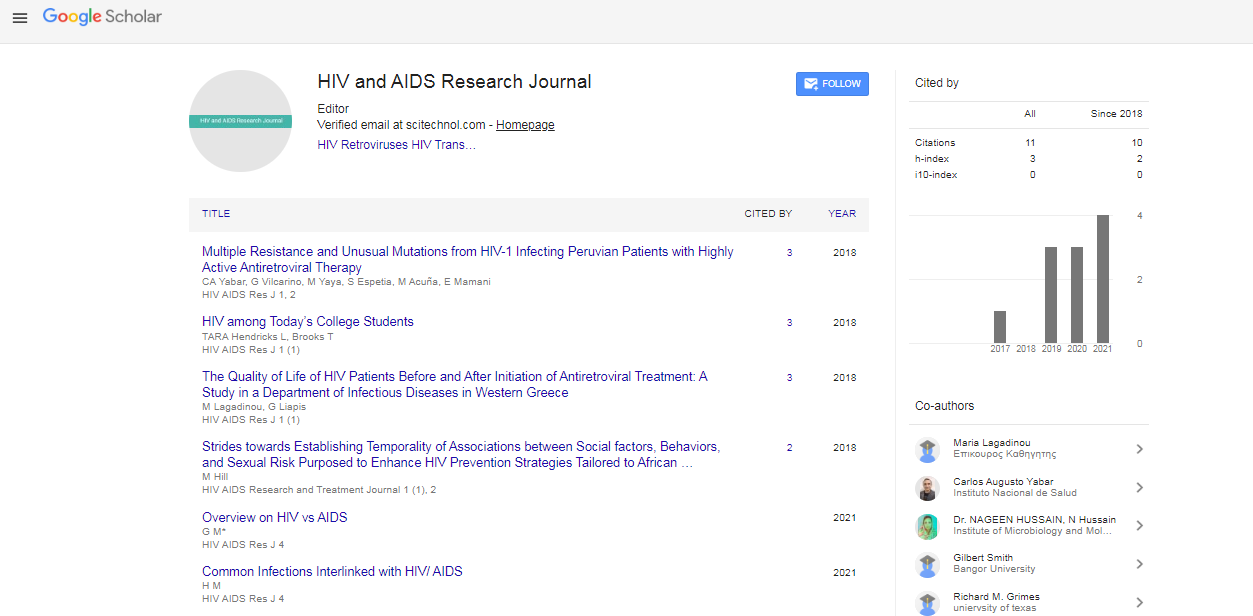Editorial, Hiv Aids Res J Vol: 3 Issue: 1
Prevalence of Human Immunodeficiency Virus, Hepatitis C Virus
Chung-Yi Chen*
Department of Medicine, Fooyin University, Daliao Dist, Kaohsiung, Taiwan
*Corresponding Author : Chung-Yi Chen
Department of Medicine, Fooyin University, Daliao Dist, Kaohsiung, Taiwan
E-mail: xx377@fy.edu.tw
Received: April 06, 2020 Accepted: April 23, 2020 Published: April 30, 2020
Citation: Chung Y (2020) Prevalence of Human Immunodeficiency Virus, Hepatitis C Virus. HIV AIDS Res J 3:1.
Abstract
Veterans are disproportionately a�?ٴected by human LmmunodeٽcLenc\ virus (HIV), hepatitis C virus (HCV), and hepatitis B virus (HBV). Homeless veterans are at particularly high risk for HIV, HCV, and HBV due to a variety of overlapping risk factors, including high rates of mental health disorders and substance use disorders. Нe prevalence of HIV, HCV, and HBV among homeless veterans nationally is currently unknown. НLs study describes national testing rates and prevalence of HIV, HCV, and HBV among homeless veterans.
Keywords: Hiv, Aids
Editorial
Veterans are disproportionately affected by human immunodeficiency virus (HIV), hepatitis C virus (HCV), and hepatitis B virus (HBV). Homeless veterans are at particularly high risk for HIV, HCV, and HBV due to a variety of overlapping risk factors, including high rates of mental health disorders and substance use disorders. The prevalence of HIV, HCV, and HBV among homeless veterans nationally is currently unknown. This study describes national testing rates and prevalence of HIV, HCV, and HBV among homeless veterans.
Using data from the Department of Veterans Affairs (VA) Corporate Warehouse Data from 2015, we evaluated HIV, HCV, and HBV laboratory testing and infection confirmation rates and diagnoses on the Problem List for nonhomeless veterans and for veterans utilizing homeless services in 2015.
To our knowledge this work represents the most comprehensive tested prevalence and population prevalence estimates of HIV, HCV, and HBV among homeless veterans nationally. The data demonstrate high prevalence of HIV, HCV, and HBV among homeless veterans, and reinforce the need for integrated healthcare services along with homeless programming.
Despite the potential high prevalence of infection, there are few data regarding the true prevalence of HIV, HCV, and HBV among homeless veterans. A small study in homeless veterans noted a HIV antibody positivity rate of 1.84%, a HCV antibody positivity rate of 41.7%, and a HBsAg positivity rate of 1.17% Another study evaluated HBV prevalence among homeless veterans admitted to a psychiatric hospital, where 3% tested positive for HBsAg These small studies done more than 10 years ago, however, may not be representative of current HIV, HCV, or HBV prevalence among homeless veterans nationally.
For demographics, patients with a reported ethnicity of Hispanic were considered Hispanic in the combined variable of race/ethnicity regardless of reported race. Cases where race and ethnicity were recorded as unknown, declined to state, or more than one race was reported, were classified as “Other.” Age was calculated as of 1 January 2015.
We determined if each veteran had VA HIV, HCV, or HBV testing in the available data through 31 December 2015. HIV testing was identified as a HIV antibody or HIV antigen/antibody test; a positive HIV antibody differentiation immunoassay, positive Western blot, or detectable HIV RNA qualified as confirmation of HIV infection. HCV testing was identified as a HCV antibody test; a detectable HCV RNA or genotype qualified as confirmation of HCV infection. HBV testing was identified as a HBsAg test; a positive HBsAg qualified as confirmation of HBV infection. Tested prevalence was calculated as the number of patients with laboratory-confirmed infection divided by the number of patients with testing.
For people who come to the VA with established diagnoses of HIV, HCV, or HBV, repeat VA testing may not occur. To assess the number of such patients and to include such patients in the population prevalence, we also identified patients who had HIV, HCV, or HBV entered on their Problem List as of 31 December 2015 but did not have VA laboratory evidence for the respective infection. Population prevalence was then calculated using the total number of patients with laboratory-confirmed infection or Problem List entry divided by the total number of patients in care in 2015.
Statistical testing is not reported since the large sample size makes extremely small numeric differences statistically significant even when such small differences are not clinically meaningful.
Testing rates, tested prevalence, and population prevalence for HIV, HCV, and HBV infection and HIV/HCV coinfection for homeless and nonhomeless veterans for the VA’s 18 regions, known as Veterans Integrated Service Networks (VISNs), along with a map of the VISNs, are available in the Supplementary Materials.
 Spanish
Spanish  Chinese
Chinese  Russian
Russian  German
German  French
French  Japanese
Japanese  Portuguese
Portuguese  Hindi
Hindi 